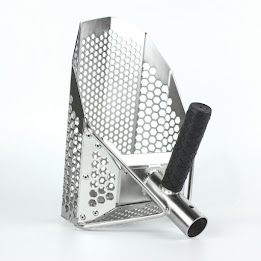Attention: Stop Digging Like a Raccoon!
Alright, fellow treasure hunters, beach explorers, and anyone who's ever been personally victimized by stubborn sand—let’s talk about a tool that deserves way more hype. If you’re still digging with your hands like some desperate raccoon, it’s time for an upgrade. That’s where Swagier Metal Detecting Sand Scoops come in—because if you’re going to dig for treasure, you might as well do it in style.
Swagier has been crafting top-tier metal detecting equipment for years, helping hobbyists in 16 countries uncover hidden treasures with ease. But which Swagier scoop is right for you? Let’s find out in this ultimate Swagier Sand Scoop Showdown!
The Showdown Begins – Which Scoop Fits Your Style?
We’re putting three of the best Swagier scoops from Ok John Metal Detectors to the test. Each has its strengths—let’s break it down.
1. Swagier V5 Metal Detecting Scoop – "The Speed Demon"
If speed is your game, the Swagier V5 is the way to go. It slices through both wet and dry sand like butter, making recoveries fast and hassle-free. Made from lightweight 304 stainless steel, it features precision-cut holes for super-fast drainage.
Weight: 1.34 kg (2.95 lbs)
Size: 12.6" x 7.9" x 9.8" wide basket
Material: 304 Stainless Steel
Hole Size: 8mm for fast drainage
Pole Fits SITA Models: V1, V2, V5, V6, V8, V10
✅ Pros:
✔ Ultra-lightweight for long hunts
✔ Large scoop area = more treasure, less digging
✔ Quick sand drainage means no time wasted
❌ Cons:
✖ Might make you overconfident and dig random spots
✖ No jet boost for extra speed (yet!)
2.
Swagier V6 Metal Detecting Scoop – "The Tank"
The V6 is built for durability. If you detect in rocky or tough conditions, this reinforced stainless steel scoop is your best bet. It’s slightly heavier than the V5 but can withstand anything you throw at it.
Weight: 1.27 kg (2.8 lbs)
Size: 12" (30 cm) length, 7.5" (19 cm) wide basket
Material: Heavy-duty 304 stainless steel
Hole Size: 13mm for larger debris drainage
Pole Fits SITA Models: V1, V2, V5, V6, V8, V10
✅ Pros:
✔ Tough and durable, even in rough conditions
✔ Works great in rocky or wet areas
✔ Built to last for years
❌ Cons:
✖ Slightly heavier than other models
✖ If you drop it on your foot, you will regret it
3.
Swagier V10 Metal Detecting Scoop – "The All-Rounder"
The V10 strikes the perfect balance between speed and strength. If you want a scoop that can handle different terrains without weighing you down, this is the one for you.
Weight: 1.1 kg (2.4 lbs)
Size: 11.5" (29 cm) length, 7" (18 cm) wide basket
Material: 304 Stainless Steel
Hole Size: 10mm for fast drainage
Pole Fits SITA Models: V1, V2, V5, V6, V8, V10
✅ Pros:
✔ Great balance between speed and durability
✔ Works well in both wet and dry sand
✔ Comfortable for long detecting sessions
❌ Cons:
Now that you know which scoop is built for speed, durability, or balance, the choice is yours! Are you the Speed Demon, the Tank, or the All-Rounder?
🔥 Drop a comment below with your pick and tell us what treasures you hope to find! Or, better yet, grab your Swagier scoop and hit the beach—your next great find could be just a scoop away! 🚀
Final Verdict: Which One is Best?
It really depends on your detecting style. If you want speed and efficiency, go with the Swagier V5. If you need a scoop that can survive an apocalypse, the Swagier V6 is your guy. But if you want a mix of power, durability, and ease of use, the Swagier V10 is the ultimate choice.
Final Verdict: Which One is Best?
No matter which one you choose, using a Swagier scoop will make your metal detecting adventures way easier (and a lot cooler). So grab your detector, hit the beach, and start digging—you never know what you’ll find! Maybe a pirate's lost treasure… or at least a pretty cool bottle cap.
Thank you Swagiers Sand Scoops for building such an amazing product. We hope that more people realize how awesome they are. I will be trying out your shovels this season and I am extremely excited about that.
Thanks again for reading everyone!
~Windy Digger















Comments
Post a Comment